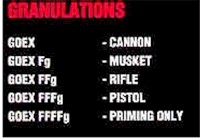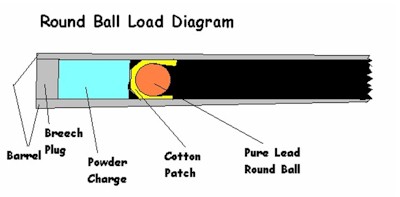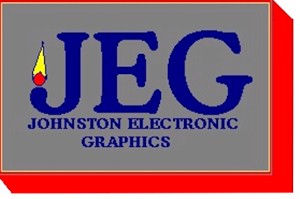Page
4
Loading
a Muzzleloader
Disclaimer:
This
is the way I do it,
I bear no responsibility
for your safety.
Everything good in life involves risk.
Firing Muzzleloaders is not
"safe".
Muzzle loading barrels
are loaded from the "business end" or muzzle, not from the rear, or breach.
The load involves
three components: Black Rifle Powder, some
sort of Wadding, and
the projectile.
Powder 
The powder is known
as
Black Powder,
a mix of Sodium Nitrate, Charcoal and Sulphur that smokes heavily when
it burns and is much less
powerful than modern rifle and pistol powders.
If modern powder
is used, you can depend on disaster.
A burst breach, broken eardrums, facial wounds, or DEATH
are all possible.
NEVER
USE MODERN POWDERS IN A MUZZLELOADER!
Many people have tried
to tell the public how much powder to use in a load.
My comment on the
subject is this: Use as little as possible
to get the job done.
Some new shooters have
a tendency to try to make their muzzleloaders match the velocity and power
of a modern firearm. This is foolish, a muzzleloader is not a modern firearm,
it is a muzzleloader. Here are several reasons why you should keep your
load reasonable:
1-- The projectile
is soft lead
(only pure, soft lead will work in muzzleloading),
it will distort
if subjected to excessive shock on discharge, causing
inaccuracy.
2-- The projectile
will skip the rifling,
if you are shooting a rifle, causing inaccuracy, if too much powder is
used.
3-- Excessive charges
wear
out the rifling and subject the breach to
excessive heat damage.
4-- Have mercy on
your shoulder,
one of the advantages of muzzleloading is a pleasant, rather than a horrible,
recoil.
5-- Hey, are you made
of money? Powder and lead CO$T!
Granulations
Powder comes in several
granulations, or grain sizes, plain Goex, or "Cannon" is the largest, 4Fg
is th finest or smallest. They are used, generally, as follows:

The smaller the grain of powder, the faster, and hotter, it burns.
Wad or Patch
Wadding or patching serves
the function of holding the ball or shot wad in place, it is also a gasket,
to make the charge behave with consistency.
Patch and Ball

The patch is a small
swatch of cotton cloth, lubricated generously with grease. that surrounds
the ball and provides a layer between the lead ball and the barrel.
A lot of debate exists
regarding how tight the ball/patch cobination should fit the barrel.
My opinion varies
depending on the situation, whether you are shooting for pleasure, shooting
for score in a match, or hunting.
Target shooting is
either serious or casual, if casual
shooting is your game, load a ball a full caliber below barrel with with
a patch that will allow easy loading, accuracy will be acceptable, and
you won't have to wipe the bore between each shot. For serious
shooting many shooters use a ball 1/2 caliber below bore width, and a fairly
tight patch, but, be advised, the bore must be wiped clean after every
shot, and a good loading tool and good technique must be used to avoid
distorting the round ball.
For hunting,
I usually use the casual loading technique, with slightly more powder.
Wad and Shot

Loading wad and shot
involves several components: Wad, Undershot
Card, Lead or Steel
Shot, and Overshot Card.
The Wad is usually
made of 1/2" thick paperboard punchouts, available commercially, but some
old timers insist on using rags. I don't like rag wads because they
produce inconsistent patterns and may start the woods on fire if they smoulder.
The question usually
arises whether to use plastic shot cups or not, I don't, for reasons of
tradition, and because they are litter that is not biodegradeable.
The Wad can be wetted
in soap water for lubrication for range shooting,
or greased for
hunting.
The Cards,
which are placed above and below the powder, simply stabilize the shot
load, keeping it in place. Cards are simply circular cutouts of heavy "tag"
weight paper stock.
Back to Start
Types
Ignition Systems
Firing a Muzzleloader
Picture Gallery





